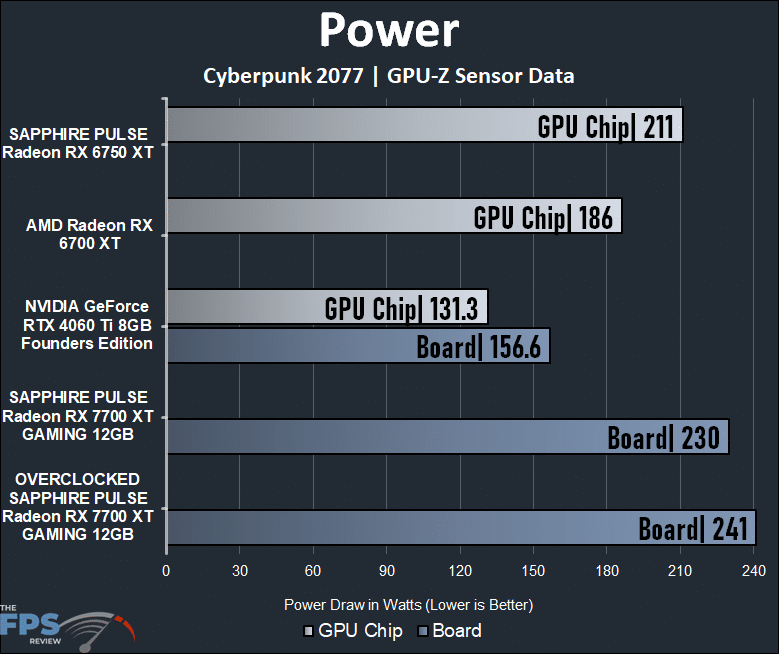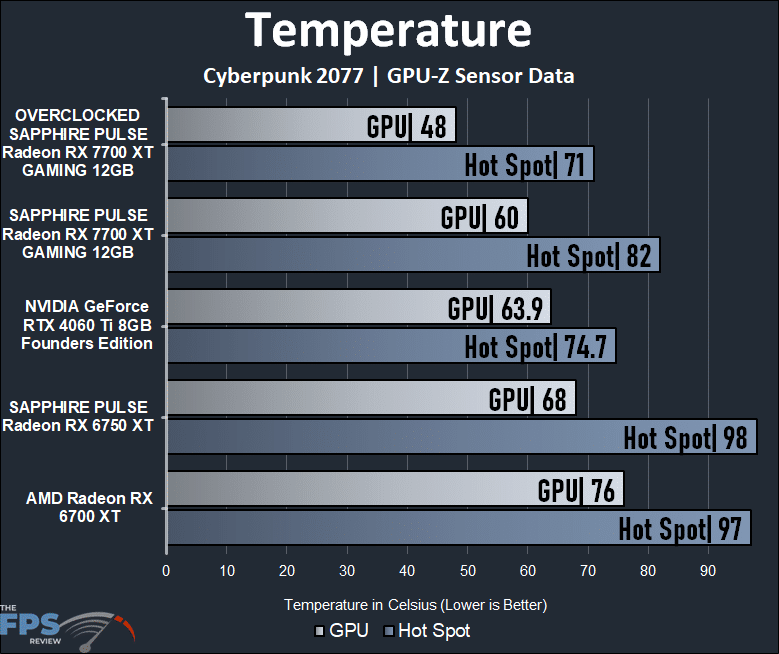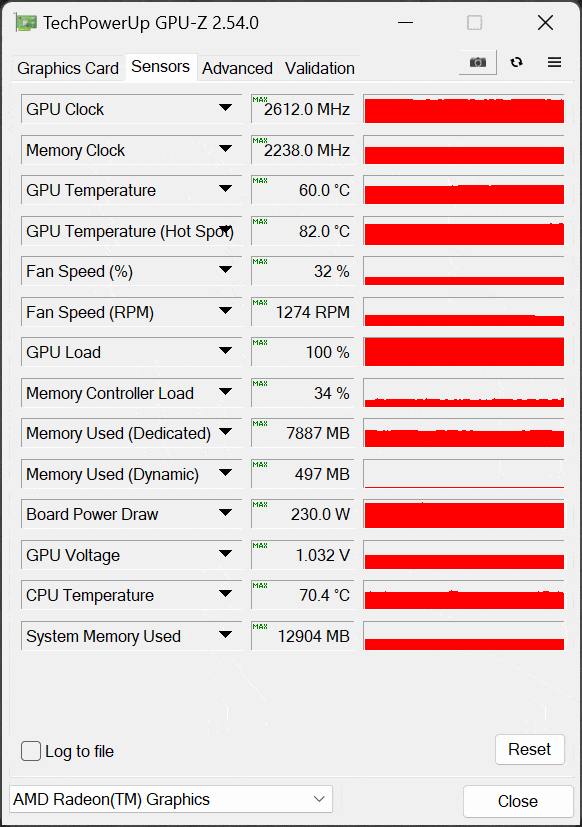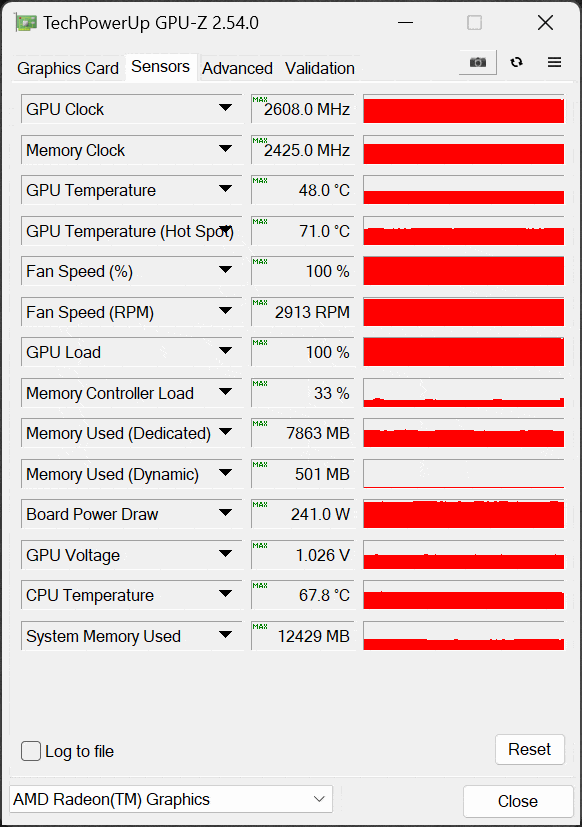Power and Temperature
To test the power and temperature we perform a manual run-through in Cyberpunk 2077 at “Ultra” settings for real-world in-game data. We use GPU-Z sensor data to record the results. We report on the GPU-Z sensor data for “Board Power” and “GPU Chip Power” when available for our Wattage data. For temperature data, we report the GPU (Edge Temp of the GPU or Package Temp) as well as Hot Spot (Junction Temperature) when available for our temperature data.

There are some holes in the power data, due to GPUz or the GPU not supporting the metric, for example, the Radeon RX 6750 XT and Radeon RX 6700 XT lack Board Power Draw, and the Radeon RX 7700 XT lacks GPU Chip Power Draw.
Overall, AMD claims the Total Board Power of the reference spec Radeon RX 7700 XT is up to 245W. SAPPHIRE’s spec for the SAPPHIRE PULSE AMD Radeon RX 7700 XT GAMING 12GB Video Card has this video card’s power draw quoted at 230W Total Board Power.
In our testing above, we can see that the Board Power reported by GPU-Z is reporting a 230W power draw, which matches the quoted specification from SAPPHIRE for the SAPPHIRE PULSE Radeon RX 7700 XT. At this power draw, the SAPPHIRE PULSE Radeon RX 7700 XT is pulling a similar power draw to the Radeon RX 6750 XT, and most likely slightly more than a Radeon RX 6700 XT would.
When we overclocked it, the total board power rose to 241W, a 5% increase in power. The performance gain we experienced followed linearly with this power increase. It seems the Radeon RX 7700 XT GPU on the SAPPHIRE PULSE Radeon RX 7700 XT is pretty much maxed out from the factory, in terms of power limit and potential for performance gain.
By comparison, the GeForce RTX 4060 Ti 8GB is an incredibly efficient GPU on power demand and runs at a lot less power. The SAPPHIRE PULSE Radeon RX 7700 XT uses 47% more power than the GeForce RTX 4060 Ti. Considering performance improvements were never that large against the GeForce RTX 4060 Ti, it shows it takes a lot more power out of the Radeon RX 7700 XT to remain competitive in performance.

The SAPPHIRE PULSE Radeon RX 7700 XT is a custom-cooled video card, and at default the GPU temp was 60c and Hot Spot was 82c. Compared to the previous generation SAPPHIRE PULSE Radeon RX 6750 XT, the new SAPPHIRE PULSE Radeon RX 7700 XT runs a lot cooler, especially on the Hot Spot temperature. The previous generation SAPPHIRE PULSE Radeon RX 6750 XT was running up to a 98c Hot Spot temp (ouch), and the GPU temp was 68c. The new SAPPHIRE PULSE Radeon RX 7700 XT runs much cooler at just 82c Hot Spot a 16-degree reduction, and 60c instead of 68c on GPU edge temp, an 8-degree reduction.
The reference design Radeon RX 6700 XT also runs hot at 97c Hot Spot and 76c GPU temp. The new SAPPHIRE PULSE Radeon RX 7700 XT just runs much cooler than the previous generation video cards no doubt about it, the SAPPHIRE PULSE Radeon RX 7700 XT cooling is better. The SAPPHIRE PULSE Radeon RX 7700 XT also runs cooler on GPU temp compared to the GeForce RTX 4060 Ti 8GB video card, but not on Hot Spot temp. When we overclocked the SAPPHIRE PULSE Radeon RX 7700 XT with 100% fan speeds the temps were incredibly low at 48c and Hot Spot at 71c, that’s a very cool running GPU.
GPU-Z Sensor Data


In the GPU-Z screenshots above you can compare the default readings (left) with the overclocked readings (right). We can see that the GPU Voltage actually dropped a little when we were overclocking, though it did not cause instability, and this may be due to the power demand. We see the board power draw increase from 230W to 241W, so power increased, but we still did not see much of a performance increase. The fans ran at just 32% at default, which is quite a quiet fan speed.
